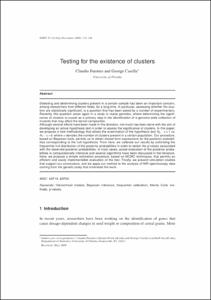Mostra el registre d'ítem simple
Testing for the existence of clusters
| dc.contributor.author | Fuentes, Claudio |
| dc.contributor.author | Casella, George |
| dc.date.accessioned | 2010-04-27T15:35:10Z |
| dc.date.available | 2010-04-27T15:35:10Z |
| dc.date.issued | 2009 |
| dc.identifier.citation | Fuentes, Claudio; Casella, George. Testing for the existence of clusters. "SORT", 2009, vol. 33, núm. 2, p. 115-158. |
| dc.identifier.issn | 1696-2281 |
| dc.identifier.uri | http://hdl.handle.net/2099/8947 |
| dc.description.abstract | Detecting and determining clusters present in a certain sample has been an important concern, among researchers from different fields, for a long time. In particular, assessing whether the clusters are statistically significant, is a question that has been asked by a number of experimenters. Recently, this question arose again in a study in maize genetics, where determining the significance of clusters is crucial as a primary step in the identification of a genome-wide collection of mutants that may affect the kernel composition. Although several efforts have been made in this direction, not much has been done with the aim of developing an actual hypothesis test in order to assess the significance of clusters. In this paper, we propose a new methodology that allows the examination of the hypothesis test H0 : =1 vs. H1 : =k, where denotes the number of clusters present in a certain population. Our procedure, based on Bayesian tools, permits us to obtain closed form expressions for the posterior probabilities corresponding to the null hypothesis. From here, we calibrate our results by estimating the frequentist null distribution of the posterior probabilities in order to obtain the p-values associated with the observed posterior probabilities. In most cases, actual evaluation of the posterior probabilities is computationally intensive and several algorithms have been discussed in the literature. Here, we propose a simple estimation procedure, based on MCMC techniques, that permits an efficient and easily implementable evaluation of the test. Finally, we present simulation studies that support our conclusions, and we apply our method to the analysis of NIR spectroscopy data coming from the genetic study that motivated this work. |
| dc.format.extent | 44 p. |
| dc.language.iso | eng |
| dc.publisher | Institut d'Estadística de Catalunya |
| dc.rights | Attribution-NonCommercial-NoDerivs 3.0 Spain |
| dc.rights.uri | http://creativecommons.org/licenses/by-nc-nd/3.0/es/ |
| dc.subject | Àrees temàtiques de la UPC::Matemàtiques i estadística::Estadística matemàtica |
| dc.subject.lcsh | Mathematical statistics |
| dc.subject.other | Hierarchical models |
| dc.subject.other | Bayesian inference |
| dc.subject.other | Frequentist calibration |
| dc.subject.other | Monte Carlo methods |
| dc.subject.other | P-values. |
| dc.title | Testing for the existence of clusters |
| dc.type | Article |
| dc.subject.lemac | Estadística matemàtica |
| dc.description.peerreviewed | Peer Reviewed |
| dc.subject.ams | Classificació AMS::62 Statistics::62F Parametric inference |
| dc.rights.access | Open Access |
| local.citation.author | Fuentes, Claudio; Casella, George |
| local.citation.publicationName | SORT |
| local.citation.volume | 33 |
| local.citation.number | 2 |
| local.citation.startingPage | 115 |
| local.citation.endingPage | 158 |


